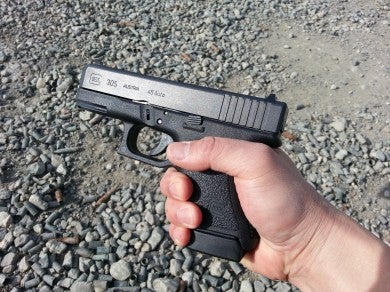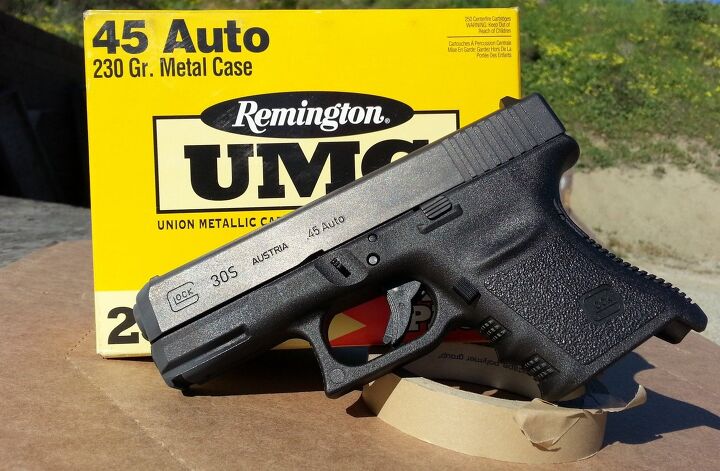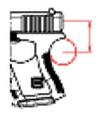The new .45ACP Glock 30S was born from a “hack” where Glock shooters tinkered a bit and married a 30SF frame with a 36 slide. These hackers felt that the 30SF was too bulky for concealed carry and that the 36, with its 6+1 capacity, did not hold enough rounds.
Glock officially solved the problem with the 30S, a slimmer slide to improve conceal carry comfort, and an increase to 10+1 capacity. I first fired the 30S at SHOT Show one month ago, and in the limited time I had with the gun I noted the (perceived) reduced recoil (Note: Perceived recoil in this case is a subjective measure of how much recoil is perceived by the author, relative to similar pistols.). I requested a test gun from Glock so I could have more trigger time to better evaluate it.

The 10-round double-stack magazine has a pinky extension which allows the 30S to fit well in the author’s average size hand.
Looking into the recoil piece, upon further research comparing the 30S to Glock’s other .45ACP subcompact models, I noticed that the Glock 30S “barrel height” (sometimes referred to as “bore axis” – Glock measures the barrel height the from the center of the bore to the forward most point of the pistol’s backstrap) is only 0.79″, compared to the 1.26″ height of the 30, 30SF, and 36.
The lower barrel height of the 30S could be one explanation for the (again, perceived) reduced recoil. For further insight, I consulted Andrew Tuohy over at the Vuurwapen Blog who noted that:
Bore axis can play a role in how a handgun behaves in the hand of the shooter. Ideally, the axis of recoil would be in line with the shooter’s arm. However, it is one small part of the equation. The mass and velocity of the projectile, as well as the mass and velocity of the slide, the distance traveled by the slide, and the weight/strength of the recoil spring, have a greater physical effect. That being said, if the shooter believes his firearm is designed in a way that reduces recoil, he will probably think it is easier to shoot than it would otherwise be.
TFB readers with a physics background are encouraged to delight us with more detail.
Using 230gr .45ACP Remington UMC ammo, I took the Glock 30S for a spin. I performed the following tests at 5 and 15 yards:
Accuracy (Untimed): 3-shot groups at my leisure, in the sun.
Speed (Timed): At the low ready, 3-shot groups with pac timer set to a random start tone with a 1.5 second follow up beep- the 3 shots were completed within the 1.5 second time frame.
For the accuracy test, I was able to produce .75″ and 1.25″ inch groups, at 5 and 15 yards, respectively. For the speed test, I produced 4.75″ inch and 5.75″ inch groups at 5 and 15 yards, respectively.
For me, the gun was accurate and fast out of the box. If I were to use the 30S for conceal carry, I would personally opt to change out the sights for night sights (such as Trijicon 3 dot tritium) or other low light sighting system, swap in a lighter recoil spring, and put in a crisper trigger (such as The Glock Store’s Fulcrum trigger) to bring the trigger pull down from its stock 5.5lbs down to around 4lbs, a common conceal carry weight.
All in all, I really like the Glock 30S and it’ll be interesting to see if it’s successful.
Chris Cheng is History Channel’s Top Shot Season 4 champion. A self-taught amateur turned pro through his Top Shot win, Cheng very much still considers himself an amateur who parachuted into this new career. He is a professional marksman for Bass Pro Shops who shares his thoughts and experiences from the perspective of a newbie to the shooting community. www.TopShotChris.com.
 Your Privacy Choices
Your Privacy Choices



